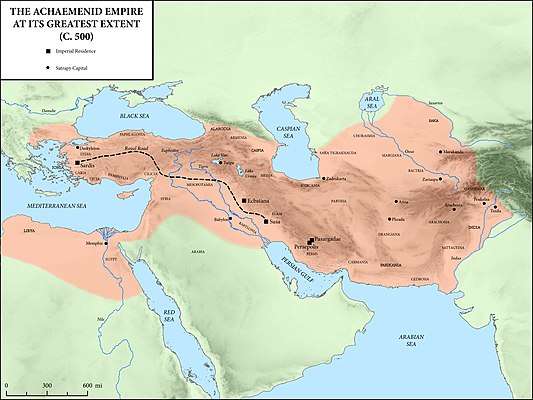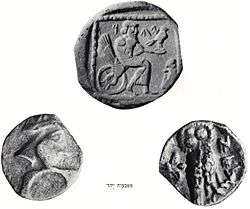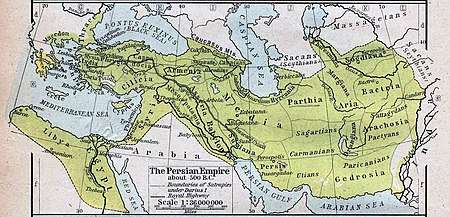Yehud Medinata
Yehud Medinata (Aramaic for Province of Judah),[1][2][3][4] or simply Yehud, was a colony of the Persian Achaemenid Empire, ruled by mostly Jewish governors. The territory was considerably smaller and with a far thinner population than its predecessor, the kingdom of Judah. The area of Yehud Medinata corresponded to the previous Babylonian province of Yehud, which was formed after the fall of the kingdom of Judah to the Neo-Babylonian Empire (c.597 after its conquest of the Mediterranean east coast, and again in 585/6 BCE after suppressing an unsuccessful Judean revolt). Yehud Medinata, part of the Persian satrapy of Eber-Nari, continued to exist for two centuries, until being incorporated into the Hellenistic empires following the conquests of Alexander the Great.
Yehud Medinata | |||||||||
|---|---|---|---|---|---|---|---|---|---|
| c. 539 BCE–c. 332 BCE | |||||||||
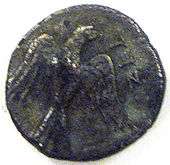 Obverse of Jewish Yehud, a silver coin from Persian period
| |||||||||
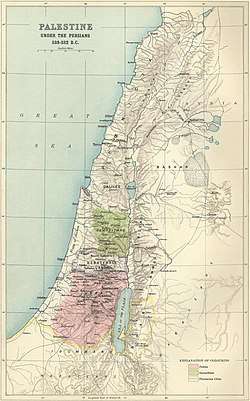 Yehud Medinata (in pink) under the Persian Empire | |||||||||
| Status | Province of the Achaemenid Empire | ||||||||
| Capital | Jerusalem 31°47′N 35°13′E | ||||||||
| Common languages | Aramaic, Hebrew, Old Persian | ||||||||
| Religion | Second Temple Judaism | ||||||||
| Historical era | Achaemenid Empire | ||||||||
| c. 539 BCE | |||||||||
| c. 332 BCE | |||||||||
| Currency | Daric, siglos | ||||||||
| |||||||||
| Today part of | |||||||||
Attempt at matching biblical to historical chronology
There is not complete agreement on the chronology of the Babylonian and Persian periods: the following table is used in this article, but alternative dates for many events are plausible. That is especially true of the chronological sequence of Ezra and Nehemiah, with Ezra 7:6-8 stating that Ezra came to Jerusalem "in the seventh year of Artaxerxes the King," without specifying whether he was Artaxerxes I (465-424 BCE) or Artaxerxes II (404-359 BCE). The probable date for his mission is 458 BCE, but it is possible that it took place in 397 BCE.
| Year | Event |
|---|---|
| 587 BCE | Conquest of Jerusalem by Babylonians; second deportation (first deportation in 597); Gedaliah installed as governor in Mizpah |
| 582? BCE | Assassination of Gedaliah; refugees flee to Egypt; third deportation to Babylon |
| 562 BCE | Jeconiah, king of Judah deported and imprisoned in Babylon in 597, released; remains in Babylon |
| 539 BCE | Cyrus the Great (Cyrus II, ruled c.550-530 BCE) conquers Babylon |
| 538 BCE | "Declaration of Cyrus" allowing Jews to return to Jerusalem |
| 530 BCE | Cambyses II (ruled 530-522 BCE) succeeds Cyrus |
| 525 BCE | Cambyses conquers Egypt |
| 522 BCE | Darius I (ruled 522-486 BCE) succeeds Cambyses |
| 521 BCE | Negotiations in Babylon between Darius and the exiled Jews |
| 520 BCE[5] | Return to Jerusalem of Zerubbabel as governor of Yehud and Joshua as High Priest |
| 520-515 BCE[5] | Rebuilding of the Temple (Second Temple) |
| 458? BCE | Arrival in Jerusalem of Ezra (7th year of the reign of Artaxerxes I, king 465-424 BCE) |
| 445/444 BCE | Arrival in Jerusalem of Nehemiah (20th year of the reign of Artaxerxes I) |
| 397? BCE (possible) |
Arrival in Jerusalem of Ezra (7th year of the reign of Artaxerxes II, king 404-358 BCE) |
| 333/332 BCE | Alexander the Great conquers the Mediterranean provinces of Persian Empire; beginning of Hellenistic age |
Background
In the late 7th century BCE Judah became a vassal-kingdom of the Neo-Babylonian Empire, but there were rival factions at the court in Jerusalem, some supporting loyalty to Babylon and others urging rebellion. In the early years of the 6th century, despite the strong remonstrances of the prophet Jeremiah and others, King Jehoiakim revolted against Nebuchadrezzar. The revolt failed, and in 597 BCE, many Judahites, including the prophet Ezekiel, were exiled to Babylon. A few years later, Judah revolted yet again. In 589 Nebuchadnezzar again besieged Jerusalem, and many Jews fled to Moab, Ammon, Edom and other countries to seek refuge. The city fell after an 18-month siege and Nebuchadnezzar again pillaged and destroyed Jerusalem and burned the Temple. Thus, by 586 BCE, much of Judah was devastated, the royal family, the priesthood, and the scribes, the country's elite, were in exile in Babylon, and the former kingdom suffered a steep decline of both economy and population.[10]
The former kingdom of Judah then became a Babylonian province Yehud, with Gedaliah, a native Judahite, as governor (or possibly ruling as a puppet king). According to Miller and Hayes, the province included the towns of Bethel in the north, Mizpah, Jericho in the east, Jerusalem, Beth-Zur in the west and En-Gedi in the south.[11] The administrative centre of the province was Mizpah.[12] On hearing of the appointment, the Jews that had taken refuge in surrounding countries returned to Judah.[13] However, before long, Gedaliah was assassinated by a member of the former royal house, and the Babylonian garrison was killed, triggering a mass movement of refugees to Egypt.[11] In Egypt, the refugees settled in Migdol, Tahpanhes, Noph, and Pathros,[14] and Jeremiah went with them as moral guardian.
The numbers deported to Babylon or who made their way to Egypt and the remnant that remained in Yehud province and in surrounding countries are subject to academic debate. The Book of Jeremiah reports that a total of 4600 were exiled to Babylon. To such numbers must be added those deported by Nebuchadnezzar in 597 BCE after the first siege to Jerusalem, when he deported the king of Judah, Jeconiah, and his court and other prominent citizens and craftsmen along with a sizable portion of the Jewish population of Judah, numbering about 10,000. The Book of Kings also suggests that it was 8000. Israel Finkelstein, a prominent archaeologist, suggests that the 4600 represented the heads of households and 8000 was the total, and 10,000 is a rounding upwards of the second number. Jeremiah also hints that an equivalent number may have fled to Egypt. Given such figures, Finkelstein suggests that three fourths of the Judahite population had remained in Judah.
History
Biblical version
In 539 BCE, Babylon fell to the Persians. That event is dated securely from non-biblical sources. In his first year (538 BCE), Cyrus the Great decreed that the deportees in Babylon could return to Yehud and rebuild the Temple.[16] Led by Zerubbabel, 42,360 exiles returned to Yehud,[17] where he and Jeshua the priest, although they were in fear of the "people of the land", re-instituted sacrifices.[18]
According to Book of Ezra, Jeshua and Zerubbabel were frustrated in their efforts to rebuild the Temple by the enmity of the "people of the land" and the opposition of the governor of "Beyond-the-River" (the satrapy of which Yehud was a smaller unit). (Ezra 3-4:4) However, in the second year of Darius (520 BCE), Darius discovered the Decree of Cyrus in the archives and directed the satrap to support the work, which he did, and the Temple was completed in the sixth year of Darius (516/515 BCE). (Ezra 6:15)
The Book of Ezra dates Ezra's arrival in Jerusalem to the second year of Artaxerxes. Its position in the narrative implies that he was Artaxerxes I in which case the year was 458 BCE. Ezra, a scholar of the commandments of Yahweh, was commissioned by Artaxerxes to rebuild the Temple and enforce the laws of Moses in Beyond-the-River. Ezra led a large party of exiles back to Yehud, where he found that Jews had intermarried with the "peoples of the land" and immediately banned intermarriage. (Ezra 6-10)
In the 20th year of Artaxerxes (almost definitely Artaxerxes I, whose twentieth year was 445/444 BCE) Nehemiah, the cup-bearer to the king and in a high official post, was informed that the wall of Jerusalem had been destroyed and was granted permission to return to Jerusalem to rebuild it. He succeeded in doing so but encountered strong resistance from the "people of the land", the officials of Samaria (the province immediately to the north of Yehud, the former kingdom of Israel) and other provinces and peoples around Jerusalem. (Nehemiah 1-7)
At then, the Book of Nehemiah abruptly switches back to Ezra, apparently with no change in the chronology, but the year is not specified. The Book of Nehemiah says that Ezra gathered the Jews together to read and enforce the law (his original commission from Darius but put into effect only now, 14 years after his arrival). Ezra argued to the people that failure to keep the law had caused the Exile. The Jews then agreed to separate themselves from the "peoples of the land" (once again, intermarriage was banned), keep Sabbath and generally observe the Law. (Nehemiah 8-12)
Current scholarship
Part of a series on the |
|---|
| History of Israel |
 |
| Ancient Israel and Judah |
| Second Temple period (530 BCE–70 CE) |
| Late Classic (70-636) |
| Middle Ages (636–1517) |
| Modern history (1517–1948) |
| State of Israel (1948–present) |
| History of the Land of Israel by topic |
| Related |
|
|
The Babylonians removed only a portion of the population of Jerusalem; of those exiles, only a small portion returned to Jerusalem (539) after the Persian conquest of Babylon, and did so over several decades. The population of Persian-period Jerusalem and the area was smaller than once believed, only a few thousands. Much of the literature which became the Hebrew bible was compiled during the Persian period, and Persian Yehud saw considerable conflict over the construction and function of the Temple and matters of cult (i.e., how God was to be worshiped). Persia controlled Yehud using the same methods it used in other colonies, and the bible reflects this, and Yehud's status as a Persian colony is crucial to understanding the society and literature of the period. The restoration of the Davidic kingdom under Persian royal patronage was clearly the project of the exile community in the early post-Exilic period. The returnees attempted to restore in Yehud the First Temple threefold leadership template of king (Sheshbazzar and Zerubbabel), high priest (Joshua, descended from the priestly line), and prophets (Haggai, Zechariah). However, by the middle of the next century, probably around 450 BCE, the kings and prophets had disappeared and only the high priest remained, joined by the scribe-sage (Ezra) and the appointed aristocrat-governor (Nehemiah). This new pattern provided the leadership model for Yehud for centuries to come.[19]
Administration and demographics
Yehud was considerably smaller than the old kingdom of Judah, stretching from around Bethel in the north to about Hebron in the south (although Hebron itself was unpopulated throughout the Persian period), and from the Jordan River and Dead Sea in the east to, but not including, the Shephelah (the slopes between the Judean highlands and the coastal plains in the west). After the destruction of Jerusalem the centre of gravity shifted northward to Benjamin; this region, once a part of the kingdom of Israel, was far more densely populated than Judah itself, and now held both the administrative capital, Mizpah, and the major religious centre of Bethel.[20] Mizpah continued as the provincial capital for over a century. The position of Jerusalem before the administration moved back from Mizpah is not clear, but from 445 BCE onwards it was once more the main city of Yehud, with walls, a temple (the Second Temple) and other facilities needed to function as a provincial capital, including, from 420 BCE, a local mint striking silver coins.[21] Nevertheless, Persian-era Jerusalem was tiny: about 1500 inhabitants, even as low as 500 according to some estimates.[22] It was the only true urban site in Yehud, the bulk of the province's population lived in small unwalled villages. This picture did not much change throughout the entire Persian period. The entire population of the province remained around 30,000. There is no sign in the archaeological record of massive inwards migration from Babylon,[23] in contradiction to the biblical account where Zerubbabel's band of returning Israelite exiles alone numbered 42,360.[17]
The Persians seem to have experimented with ruling Yehud as a client-kingdom, but this time under the descendants of Jehoiachin, who had kept his royal status even in captivity.[24] Sheshbazzar, the governor of Yehud appointed by Cyrus in 538, was of Davidic origin, as was his successor (and nephew) Zerubbabel; Zerubbabel in turn was succeeded by his second son and then by his son-in-law, all of them hereditary Davidic governors of Yehud, a state of affairs that ended only around 500 BCE.[25] This hypothesis — that Zerubbabel and his immediate successors represented a restoration of the Davidic kingdom under Persian overlordship — cannot be verified, but it would be in keeping with the situation in some other parts of the Persian Empire, such as Phoenicia.[26]
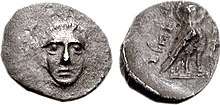
The second and third pillars of the early period of Persian rule in Yehud, copying the pattern of the old Davidic kingdom destroyed by the Babylonians, were the institutions of High Priest and Prophet. Both are described and preserved in the Hebrew Bible in the histories of Ezra-Nehemiah-Chronicles and in the books of Zechariah, Haggai and Malachi, but by the mid-5th century BCE the prophets and Davidic kings had ended, leaving only the High Priest.[28] The practical result was that after c.500 BCE Yehud became in practice a theocracy, ruled by a line of hereditary High Priests.[29]
The governor of Yehud would have been charged primarily with keeping order and seeing that tribute was paid. He would have been assisted by various officials and a body of scribes, but there is no evidence that a popular "assembly" existed, and he would have had little discretion over his core duties.[30] Evidence from seals and coins suggests that most, if not all, of the governors of Persian Yehud were Jewish, a situation which conforms with the general Persian practice of governing through local leaders.[31]
Governors of Yehud Medinata
- Sheshbazzar, circa 538
- Zerubbabel, until 510. led the first wave of Jewish exiles back to Judea after the fall of Babylonian Empire to Cyrus the Great. His family, however, remained behind in Nehardea.
- Elnathan
- Jehoezer
- Ahzai
- Ezra ben Seraiah 458-430, the subject of the Old Testament Book of Ezra.
- Nehemiah ben Hachaliah 445-433,
- Bagoses the Persian late 400's
- Yehezqiyah early 300's
Religion and community
There is a general consensus among biblical scholars that ancient Judah during the 9th and 8th centuries BCE was basically polytheistic, with Yahweh as a national god in the same way that surrounding nations each had their own national gods.[32] Monotheistic themes arose as early as the 8th century, in opposition to Assyrian royal propaganda, which depicted the Assyrian king as "Lord of the Four Quarters" (the world), but the Exile broke the competing fertility, ancestor and other cults and allowed it to emerge as the dominant theology of Yehud.[33] The minor gods or "sons of Yahweh" of the old pantheon now turned into a hierarchy of angels and demons in a process that continued to evolve throughout the time of Yehud and into the Hellenistic age.[32]
Persian Zoroastrianism certainly influenced Judaism. Although the exact extent of that influence continues to be debated, they shared the concept of God as Creator, as the one who guarantees justice and as the God of heaven. The experience of exile and restoration itself brought about a new world view in which Jerusalem and the House of David continued to be central ingredients, and the destruction of the Temple came to be regarded as a demonstration of Yahweh's strength.[34]
Possibly the single most important development in the post-Exilic period was the promotion and eventual dominance of the idea and practice of Jewish exclusivity, the idea that the Jews (meaning followers of the god of Israel and of the law of Moses) were or should be a race apart from all others. According to Levine, that was a new idea, originating with the party of the golah, those who returned from the Babylonian exile.[35] In spite of the reforming ex-Babylonian golah leader, Nehemiah, refusing the request of the Yahweh-worshiping Samaritans to help rebuild the Temple, and Ezra's horror at learning that Yehudi Yahweh-worshipers were intermarrying with non-Yehudis (possibly even non Yahweh-worshipers), the relations with the Samaritans and other neighbours were, in fact, close and cordial.[35] Comparison of Ezra-Nehemiah and Chronicles bears this out: Chronicles opens participation in Yahweh-worship to all twelve tribes and even to foreigners, but for Ezra-Nehemiah, "Israel" means the tribes of Judah and Benjamin alone as well as the holy tribe of Levi.[36]
Literature and language
Scholars believe that in the Persian period the Torah assumed its final form, the history of ancient Israel and Judah contained in the books from Joshua to Kings was revised and completed and the older prophetic books were redacted.[34] New writing included the interpretation of older works, such as the Book of Chronicles, and genuinely original work including Ben Sira, Tobit, Judith, 1 Enoch and, much later, Maccabees. The literature from Ben Sira onwards is increasingly permeated with references to the Hebrew Bible in the present form, suggesting the slow development of the idea of a body of "scripture" in the sense of authoritative writings.[37]
One of the more important cultural shifts in the Persian period was the rise of Aramaic as the predominant language of Yehud and the Jewish diaspora. Originally spoken by the Aramaeans, it was adopted by the Persians and became the lingua franca of the empire, and already in the time of Ezra, it was necessary to have the Torah readings translated into Aramaic for them to be understood by Jews.[38]
See also
- History of the Jews and Judaism in the Land of Israel
- Intertestamental period
- Jew (word)
- Judaea (Roman province)
- The Return to Zion
- Yehud coinage
- Zion
References
- Spolsky, Bernard (2014). The Languages of the Jews: A Sociolinguistic History. Cambridge University Press. p. 39. ISBN 978-1-107-05544-5. Retrieved 4 May 2020.
- Gooder, Paula (2013). The Bible: A Beginner's Guide. Beginner's Guides. Oneworld Publications. p. 27. ISBN 978-1-78074-239-7. Retrieved 4 May 2020.
- "medinah". Bible Hub: Search, Read, Study the Bible in Many Languages. Retrieved 4 May 2020.
- Philologos (21 March 2003). "The Jews of Old-Time Medina". Forward. The Forward Association. Retrieved 4 May 2020.
...in the book of Esther,...the opening verse of the Hebrew text tells us that King Ahasuerus ruled over 127 medinas from India to Ethiopia — which the Targum, the canonical Jewish translation of the Bible into Aramaic, renders not as medinata, "cities," but as pilkhin, "provinces."
- Rainer Albertz, Israel in Exile: The History and Literature of the Sixth Century BCE, (2003) ISBN 1-58983-055-5, p.xxi
- O'Brien, Patrick Karl (2002). Atlas of World History. Oxford University Press. pp. 42–43. ISBN 9780195219210.
- Philip's Atlas of World History. 1999.
- Davidson, Peter (2018). Atlas of Empires: The World's Great Powers from Ancient Times to Today. i5 Publishing LLC. ISBN 9781620082881.
- Barraclough, Geoffrey (1989). The Times Atlas of World History. Times Books. p. 79. ISBN 0723003041.
- Lester L. Grabbe, A History of the Jews and Judaism in the Second Temple Period – Vol 1: A History of the Persian Province of Judah (2004)] ISBN 0-567-08998-3, p.28.
- James Maxwell Miller and John Haralson Hayes, A History of Ancient Israel and Judah (1986) ISBN 0-664-21262-X, p.xxi, 425.
- 2 Kings 25:22-24, Jeremiah 40:6-8
- Jeremiah 40:11-12
- Jeremiah 44:1
- Diane V. Edelman, "The Triumph of Elohim", p.223
- Ezra 1:3-4
- Nehemiah 7:66-67 and Ezra 2:64-65
- Ezra 3:2-5
- Lee I. Levine, Jerusalem: portrait of the city in the second Temple period (538 B.C.E.-70 C.E.), p.42
- Philip R. Davies, The Origin of Biblical Israel
- Izaak J. de Hulster, "Iconographic Exegesis and Third Isaiah", pp.135-6
- Oded Lipschits, "Persian Period Finds from Jerusalem: Facts and Interpretation", Journal of Hebrew Scriptures (vol.9, art.20, 2009)
- Lester L. Grabbe, "A history of the Jews and Judaism in the Second Temple Period, Volume 1", p.30
- Herbert Niehr, Religio-Historical Aspects of the Early Post-Exilic Period, in Bob Becking, Marjo Christina Annette Korpel (eds), "The Crisis of Israelite Religion: Transformation of Religious Tradition in Exilic & Post-Exilic Times" (Brill, 1999) pp.229-30
- Herbert Niehr, Religio-Historical Aspects of the Early Post-Exilic Period, in Bob Becking, Marjo Christina Annette Korpel (eds), "The Crisis of Israelite Religion: Transformation of Religious Tradition in Exilic & Post-Exilic Times" (Brill, 1999)pp.229-231
- Herbert Niehr, Religio-Historical Aspects of the Early Post-Exilic Period, in Bob Becking, Marjo Christina Annette Korpel (eds), "The Crisis of Israelite Religion: Transformation of Religious Tradition in Exilic & Post-Exilic Times" (Brill, 1999)p.231
- Bar-Kochva, Bezalel (2010). Pseudo Hecataeus, "On the Jews": Legitimizing the Jewish Diaspora. Univ of California Press. p. 86. ISBN 9780520268845.
- Lee I. Levine, "Jerusalem: portrait of the city in the second Temple period (538 B.C.E.-70 C.E.)" p.42
- Stephen M. Wylen, "The Jews in the time of Jesus: an introduction", p.25
- Lester L. Grabbe, "A history of the Jews and Judaism in the Second Temple Period, Volume 1", p.154-5
- Lee I. Levine, "Jerusalem: portrait of the city in the second Temple period (538 B.C.E.-70 C.E.)" p.34
- Lester L. Grabbe, "A history of the Jews and Judaism in the Second Temple Period", vol.1 (T&T Clark International, 2004), pp.240-244
- Christopher B. Hayes, Religio-historical Approaches: Monotheism, Morality and Method, in David L. Petersen, Joel M. LeMon, Kent Harold Richards (eds), "Method Matters: Essays on the Interpretation of the Hebrew Bible in Honor of David L. Petersen", pp.178-181
- Izaak J. de Hulster, "Iconographic Exegesis and Third Isaiah", pp.136-7
- Levine, Lee I., "Jerusalem: portrait of the city in the second Temple period (538 B.C.E.-70 C.E.)" (Jewish Publication Society, 2002) p.37
- Steven L. McKenzie, Matt Patrick Graham, "The Hebrew Bible today: an introduction to critical issues" (Westminster John Knox Press, 1998) p.204
- Lester L. Grabbe, "A history of the Jews and Judaism in the Second Temple Period", Volume 1, p.238-9
- Levine, Lee I., "Jerusalem: portrait of the city in the second Temple period (538 B.C.E.-70 C.E.)" (Jewish Publication Society, 2002) pp.36-7
External links
Maps
- Yehud Medinata map, CET – Center For Educational technology
- Yehud Medinata Border map, CET – Center For Educational technology
Books
- Becking, Bob, and Korpel, Marjo Christina Annette (eds), "The Crisis of Israelite Religion: Transformation of Religious Tradition in Exilic & Post-Exilic Times" (Brill, 1999)
- Bedford, Peter Ross, "Temple restoration in early Achaemenid Judah" (Brill, 2001)
- Berquist, Jon L., "Approaching Yehud: new approaches to the study of the Persian period" (Society of Biblical Literature, 2007)
- Blenkinsopp, Joseph, "Judaism, the first phase: the place of Ezra and Nehemiah in the origins of Judaism" (Eerdmans, 2009)
- Grabbe, Lester L., "A history of the Jews and Judaism in the Second Temple Period", vol.1 (T&T Clark International, 2004)
- Levine, Lee I., "Jerusalem: portrait of the city in the second Temple period (538 B.C.E.-70 C.E.)" (Jewish Publication Society, 2002)
- Lipschitz, Oded, "The Fall and Rise of Jerusalem" (Eisenbrauns, 2005)
- Lipschitz, Oded, and Oeming, Manfred (eds), "Judah and the Judeans in the Persian period" (Eisenbrauns, 2006)
- Lipschitz, Oded, and Oeming, Manfred (eds), "Judah and the Judeans in the fourth century B.C.E." (Eisenbrauns, 2006)
- Middlemas, Jill Anne, "The troubles of templeless Judah" (Oxford University Press, 2005)
- Stackert, Jeffrey, "Rewriting the Torah: literary revision in Deuteronomy and the holiness code" (Mohr Siebeck, 2007)
- Nodet, Étienne, "A search for the origins of Judaism: from Joshua to the Mishnah" (Sheffield Academic Press, 1999, original edition Editions du Cerf, 1997)
- Vanderkam, James, "An introduction to early Judaism" (Eerdmans, 2001)
